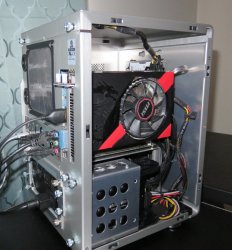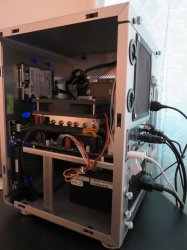- Joined
- Jan 13, 2014
- Messages
- 436 (0.10/day)
- Location
- Riga
| System Name | Pukeko |
|---|---|
| Processor | Ryzen 5 3600 |
| Motherboard | MSI B450 Gaming Plus Max |
| Cooling | Hyper 212 Black Edition |
| Memory | Corsair Vengeance LPX 16GB 3000MHz DDR4 CL15 |
| Video Card(s) | Asus RX 5600 XT TUF Gaming X3 OC |
| Storage | XPG SX8200 Pro 256GB, Crucial MX500 1TB |
| Display(s) | 2x ASUS TUF Gaming VG249Q |
| Case | NZXT, H510i, Matte Black/Red, Tempered Glass |
| Audio Device(s) | TUF Gaming H3 |
| Power Supply | Seasonic PRIME Ultra 550W Gold |
| Mouse | Touchpad + Logitech MX518 |
| Keyboard | Cooler Master, CK 350, Outemu Red |
| Software | Windows 10 |
| Benchmark Scores | 7,42,69 and 666 |
Positive pressure here: 2x 140's in the front as input, 1 140 in the bottom also as input and 1 140 in the rear as exhaust. The loudest thing in the case are 2 HDD's. When I build the system 2 years ago my CPU was idling at 20C, now at about 30C.





















 Ok I guess I get paid pretty well for what I do. Its the heat that cost $ AC is cheap. I have a 10 year old 10,000 BTU unit that cools about three rooms pretty good. As long as the CPU and pump are lower than the top of the rad your good. Any air will get caught up in the top and not get pulled down to the pump hopefully. Having the hoses come out of the bottom and up to the CPU can trap air. But its an easy fix to move the system around and get it out
Ok I guess I get paid pretty well for what I do. Its the heat that cost $ AC is cheap. I have a 10 year old 10,000 BTU unit that cools about three rooms pretty good. As long as the CPU and pump are lower than the top of the rad your good. Any air will get caught up in the top and not get pulled down to the pump hopefully. Having the hoses come out of the bottom and up to the CPU can trap air. But its an easy fix to move the system around and get it out
